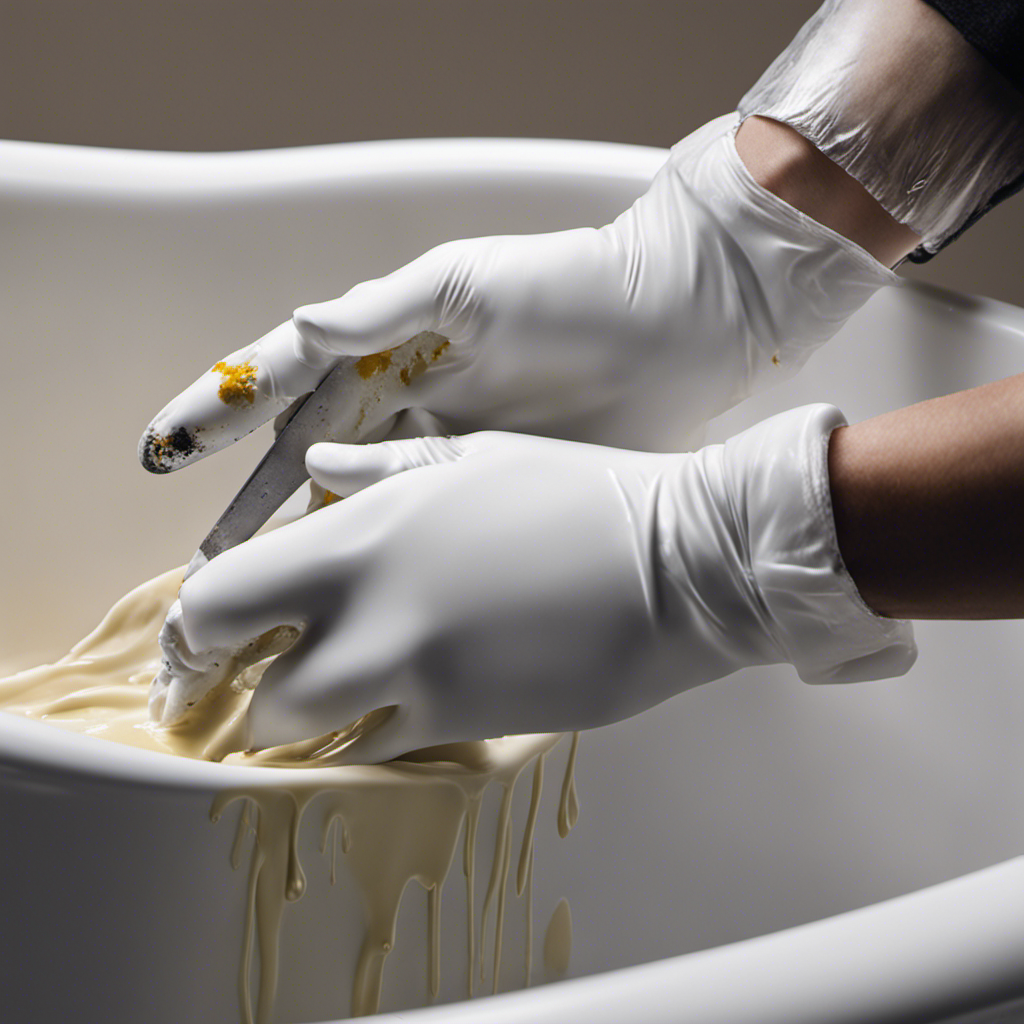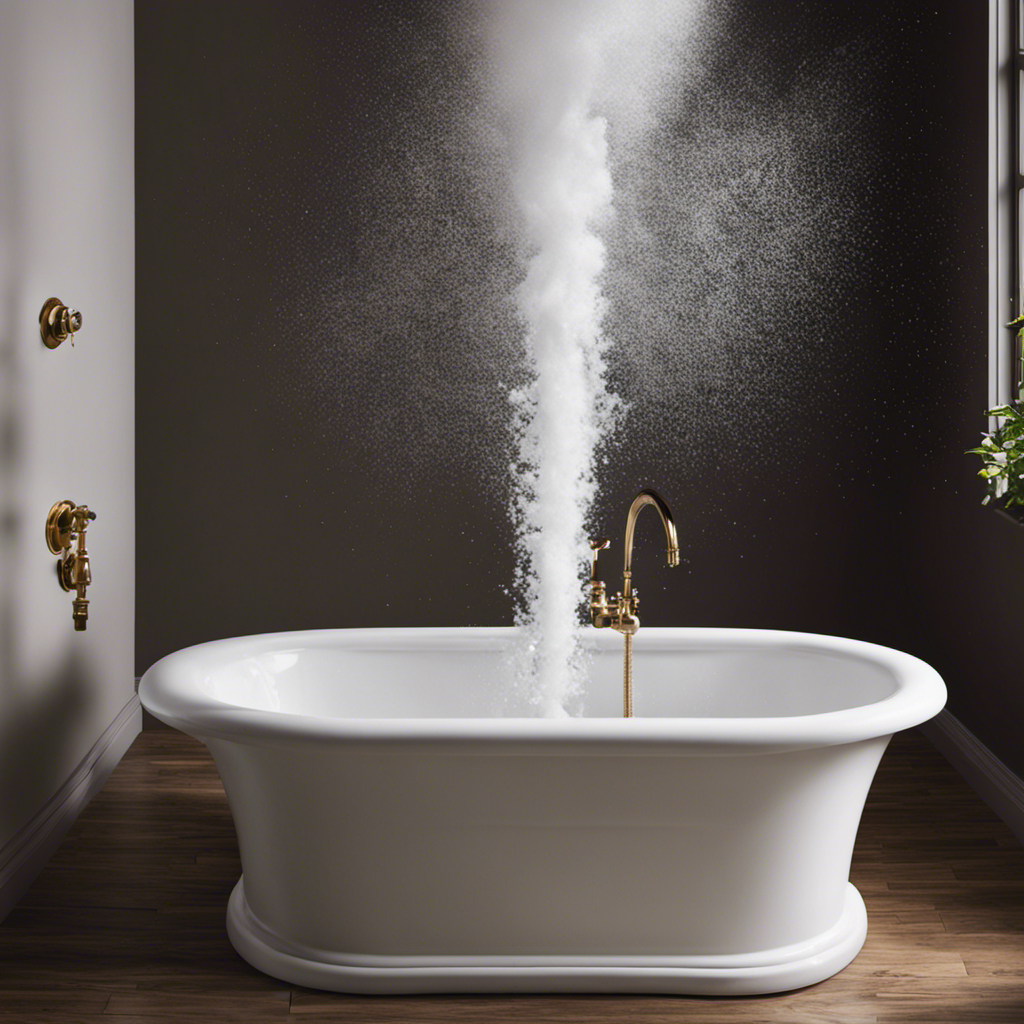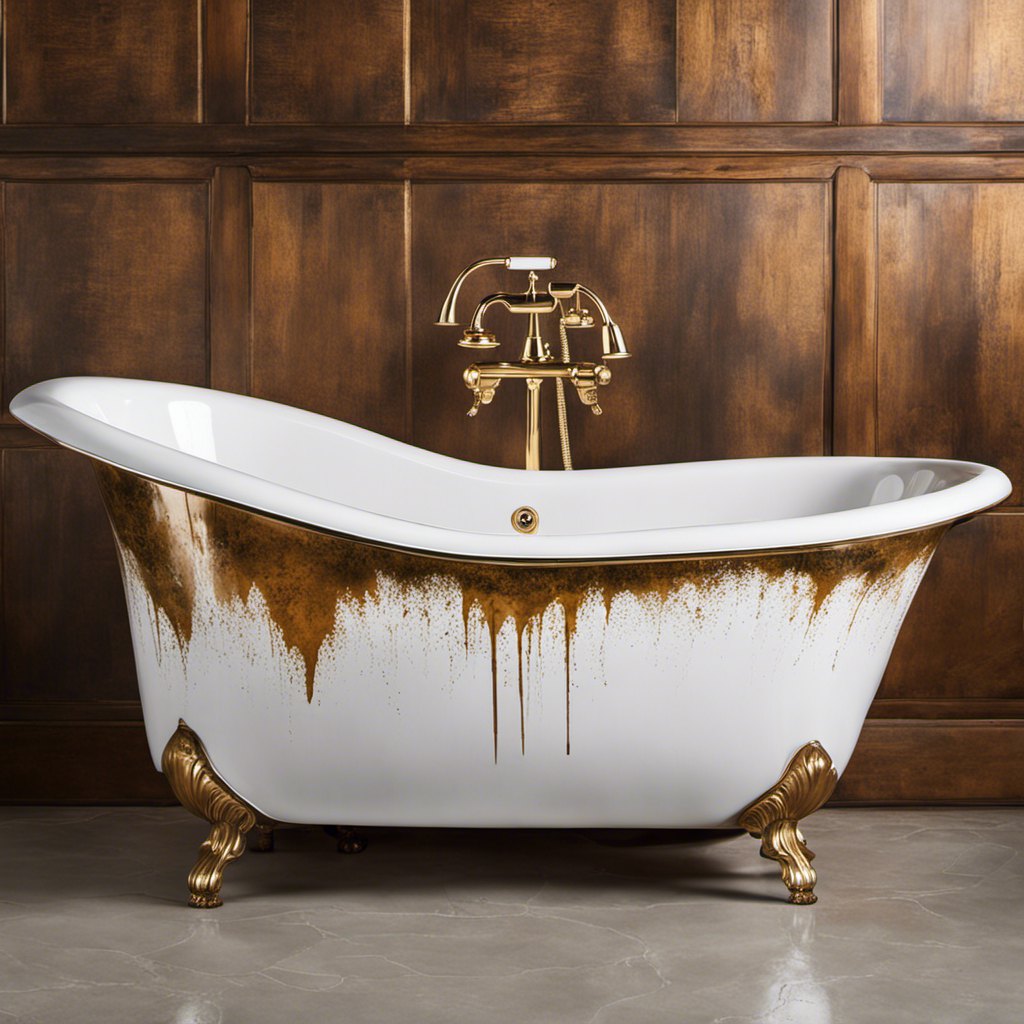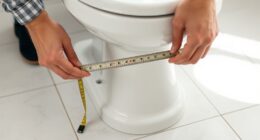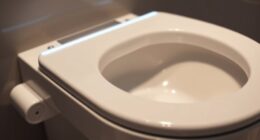As someone who loves DIY projects, I understand the frustration of finding paint splatters on your bathtub. But fear not! In this article, I’m going to show you exactly how to remove paint from a bathtub.
By following these simple steps, you’ll be able to restore your bathtub to its pristine condition in no time. So, grab your supplies and let’s get started!
Key Takeaways
- Safety precautions are essential when removing paint from a bathtub, including wearing protective gloves, eyewear, and a respirator, as well as ensuring proper ventilation and eye protection.
- Gathering the necessary supplies, such as a paint scraper, wire brush, sandpaper, plastic drop cloth, and cleaning bucket, is important before starting the paint removal process.
- Proper preparation of the bathtub surface involves removing loose paint or debris, thoroughly cleaning the bathtub, and paying attention to stubborn paint stains.
- When applying the paint remover, it is crucial to wear protective gear, use recommended application tools, work in small sections for better control, prevent the product from drying out too quickly, ensure even coverage and effective removal, and work in a well-lit area.
Safety Precautions
Before you start removing the paint from the bathtub, make sure you’re wearing protective gloves and eyewear. Safety precautions are essential when dealing with potentially harmful substances like paint removers.
First and foremost, it is crucial to wear a respirator to protect your lungs from inhaling any harmful fumes. Respirator use is especially important in enclosed spaces, such as a bathroom, where ventilation may be limited.
Additionally, wearing protective eyewear is crucial to shield your eyes from any splashes or debris that may occur during the paint removal process. These simple safety measures can greatly reduce the risk of any accidents or injuries while working on removing paint from your bathtub.
Gathering Supplies
First, you’ll need to gather all the supplies necessary for the task at hand. Here are the recommended tools you’ll need: a paint scraper or putty knife, a wire brush, sandpaper (medium and fine grit), a plastic drop cloth or tarp, a bucket, gloves, safety goggles, and a face mask. These tools will help you effectively remove the paint while ensuring your safety. It’s important to take safety measures when dealing with paint removal, such as wearing gloves to protect your hands from chemicals and sharp edges, safety goggles to shield your eyes, and a face mask to prevent inhaling any harmful fumes or dust.
Once you have gathered all the necessary supplies, you can move on to preparing the surface for paint removal.
Preparing the Surface
To properly prepare the surface, you’ll want to make sure it is clean and free of any debris or loose materials. Here are some steps you can take to ensure a thorough preparation before removing paint from your bathtub:
-
Gather the necessary cleaning products: Before starting, make sure you have the right supplies on hand. Recommended cleaning products include a mild detergent or dish soap, a non-abrasive scrub brush, a plastic scraper, and a sponge or cloth.
-
Allow enough preparation time: Depending on the condition of the bathtub and the type of paint, you may need to spend some time preparing the surface. Plan for at least 30 minutes to an hour to ensure a proper cleaning.
-
Remove any loose paint or debris: Begin by using a plastic scraper to gently scrape off any loose paint or debris from the surface of the bathtub. This will help create a smooth and even surface to work with.
-
Clean the bathtub thoroughly: Once the loose paint has been removed, use a mild detergent or dish soap and a non-abrasive scrub brush to clean the entire bathtub. Pay special attention to any areas with stubborn paint stains, and use the scrub brush to gently scrub away the paint.
Applying the Paint Remover
When it comes to applying paint remover, it’s important to take certain safety precautions. This includes wearing protective gloves, goggles, and a mask to avoid any contact with harmful chemicals.
Additionally, using the recommended application tools, such as a brush or sponge, can help ensure even coverage and effective removal.
Lastly, applying the paint remover in small sections allows for better control and prevents the product from drying out too quickly.
Safety Precautions for Application
Before starting, it’s important to take safety precautions when applying paint removal products to a bathtub. Here are four key safety measures to keep in mind:
-
Wear protective clothing: Put on gloves, safety goggles, and a face mask to shield yourself from potential chemical splashes and fumes. This will prevent any harm to your skin, eyes, and respiratory system.
-
Ensure proper ventilation: Open windows and doors to allow fresh air to circulate while working. This will minimize the inhalation of toxic fumes and maintain a safe environment.
-
Follow instructions carefully: Read the product label thoroughly and adhere to the recommended application guidelines. Different paint removal techniques require specific procedures, so it’s crucial to follow instructions to avoid accidents or damage to the bathtub surface.
-
Work in a well-lit area: Proper lighting will help you see clearly and ensure a more accurate application. This will reduce the chances of any mishaps and ensure a successful paint removal process.
Recommended Application Tools
Now that we’ve discussed the safety precautions for applying paint remover to a bathtub, let’s move on to the recommended application tools. Using the right tools can make a significant difference in the effectiveness and efficiency of the paint removal process.
First and foremost, I highly recommend wearing protective gloves and goggles to safeguard your hands and eyes. Additionally, a chemical-resistant brush or sponge is essential for applying the paint remover evenly and thoroughly. This will ensure that the product reaches all the painted surfaces and penetrates the layers of paint effectively.
One common mistake people make is using abrasive materials, such as steel wool or a harsh scrub brush, to remove the paint. These can damage the bathtub surface and leave scratches. Instead, opt for a soft cloth or plastic scraper to gently lift the softened paint without causing any harm.
Applying in Small Sections
To ensure an even and thorough application, it’s best to work in small sections when applying the paint remover. This method allows for better control and coverage, ensuring that every inch of the bathtub is treated properly.
Here are four reasons why working in small sections is the most effective approach:
-
Precision: By focusing on one area at a time, you can apply the paint remover with precision, minimizing the risk of missing any spots or leaving behind stubborn paint residue.
-
Even Application: Working in small sections ensures an even distribution of the paint remover, preventing inconsistent results and patches of paint that are difficult to remove.
-
Time Management: Breaking the task into smaller sections allows for better time management. You can prioritize and tackle each section efficiently, making the overall process more manageable and less overwhelming.
-
Alternative Methods: When working in small sections, you can also experiment with alternative methods, such as using a brush or a sponge, to see which technique works best for your specific bathtub surface.
Scrubbing and Removing the Paint
When it comes to removing paint, there are a few key points to consider: chemical paint strippers and alternative scrubbing methods.
Chemical paint strippers are a popular choice for their effectiveness in breaking down and removing tough paint.
However, for those who prefer a more eco-friendly approach or have sensitivities to chemicals, alternative scrubbing methods can be equally effective and safer.
In this discussion, we will explore the pros and cons of both options to help you choose the best method for your paint removal needs.
Chemical Paint Strippers
You can use chemical paint strippers to effectively remove paint from a bathtub. These powerful solutions are specifically designed to break down and dissolve paint, making it easier to scrape off.
Here are some important discussion ideas regarding the use of chemical paint strippers:
-
Health risks: It is crucial to follow safety precautions when using chemical paint strippers. These products contain strong chemicals that can be harmful if not used correctly. Make sure to wear protective gloves, goggles, and a mask to avoid skin and respiratory irritation.
-
Environmental concerns: Chemical paint strippers often contain volatile organic compounds (VOCs) that can contribute to air pollution and harm the environment. It is important to choose low VOC or eco-friendly options to minimize the impact on the ecosystem.
-
Proper disposal: After using chemical paint strippers, it is essential to dispose of the waste properly. Check local regulations for guidelines on how to dispose of paint-stripped residue and empty containers.
-
Alternatives: If health risks and environmental concerns are a major factor, consider exploring alternative methods such as steam stripping or abrasive methods to remove paint from your bathtub.
Alternative Scrubbing Methods?
If health risks and environmental concerns are a major factor, it’s worth exploring alternative methods such as steam stripping or abrasive techniques. These alternative cleaning techniques can be just as effective at removing paint from a bathtub, while being safer for your health and the environment. Steam stripping involves using hot steam to soften the paint, making it easier to scrub off. Abrasive techniques, on the other hand, involve using materials like sandpaper or wire brushes to physically remove the paint. Here is a table comparing the two methods:
| Method | Effectiveness | Health & Environmental Impact |
|---|---|---|
| Steam Stripping | High | Low (no harsh chemicals) |
| Abrasive Techniques | High | Medium (some dust and debris) |
Cleaning and Finishing Touches
After scrubbing off the paint, use a clean cloth to polish the bathtub. This will help remove any remaining residue and give the tub a nice shine.
Here are some additional finishing touches to consider:
-
Apply a protective layer: Consider applying a sealant or wax to protect the surface of the bathtub from future stains and spills. This will make it easier to clean and maintain in the long run.
-
Check for any missed spots: Carefully inspect the bathtub to ensure all the paint has been removed. Use a flashlight to identify any hidden areas that may have been overlooked during the cleaning process.
-
Rinse thoroughly: After polishing, rinse the bathtub thoroughly with warm water to remove any cleaning products or residue. This will help prevent any potential damage to the tub’s surface.
-
Prevent future paint spills: To avoid future paint spills, use drop cloths or plastic sheets to protect the bathtub before starting any painting projects in the vicinity.
Conclusion
In conclusion, removing paint from a bathtub can be a challenging task, but it can be accomplished effectively with the right supplies and techniques.
Firstly, it is important to take safety precautions when removing paint from a bathtub. This includes wearing protective gloves and goggles to protect your skin and eyes from any harmful chemicals.
Next, gather the necessary supplies for the paint removal process. This may include a paint remover specifically designed for bathtubs, a scrub brush or sponge, and a bucket of warm water.
Before applying the paint remover, it is crucial to properly prepare the bathtub. This involves thoroughly cleaning the surface to remove any dirt or grime that may interfere with the paint removal process.
Once the bathtub is clean, apply the paint remover according to the instructions on the product. Allow the remover to sit for the recommended amount of time to effectively dissolve the paint.
After the paint remover has done its job, use a scrub brush or sponge to gently scrub away the paint. Be thorough in your cleaning process to ensure a smooth and glossy finish.
Remember to take your time and be patient throughout the paint removal process. Removing paint from a bathtub is like peeling away layers of color to reveal the shining beauty beneath.
In summary, by taking safety precautions, gathering the necessary supplies, and properly preparing and applying the paint remover, you can successfully scrub away the paint and restore your bathtub to its original state.
